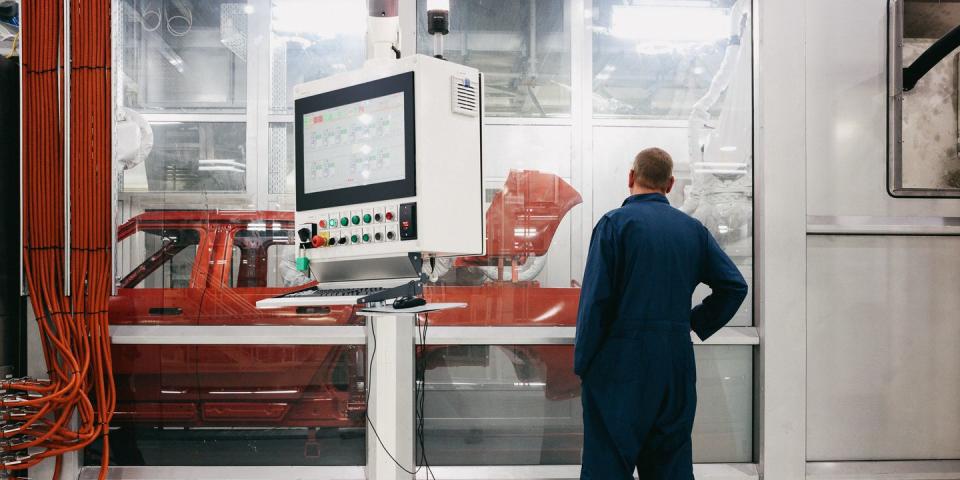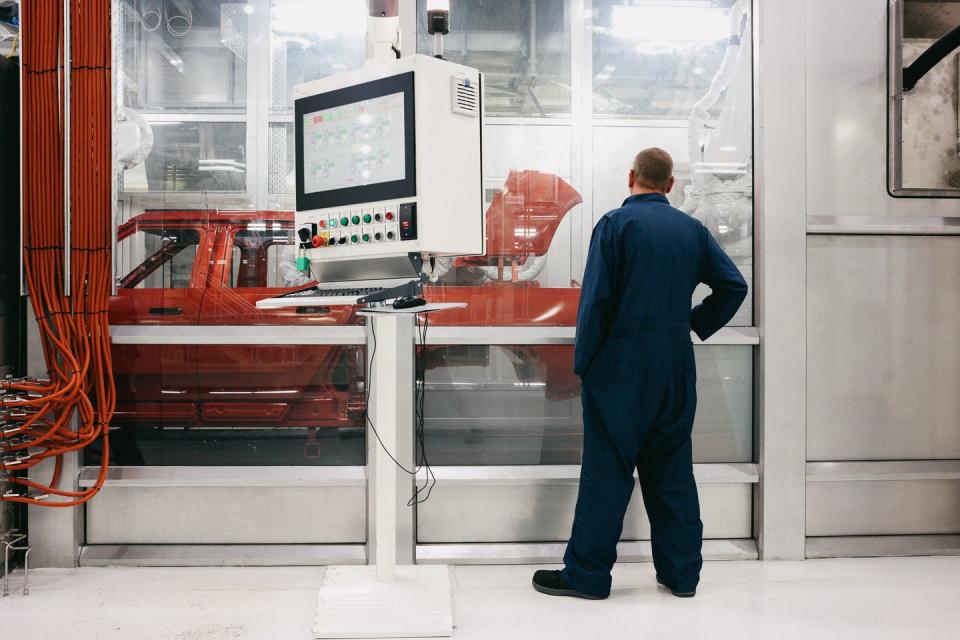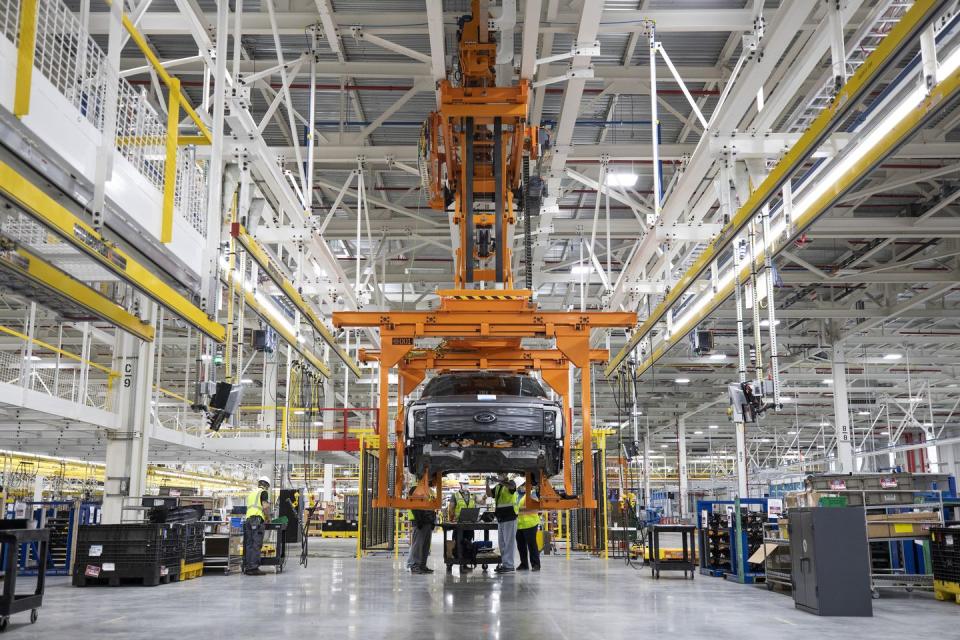Why Car Companies Can't Simply Fix Their EV Battery Supply Problems


The pandemic, the chip shortage, and now the Ukraine war have given even the average Joe a hard-earned appreciation of the value of supply chains, and shelves-and-showrooms overflowing with goods that we’d all taken for granted. This all has driven the car industry to chase a new strategic ideal, to control the battery-and-EV supply chain in biblical fashion, from dust to dust: Beginning from (ideally) dirt-common, ethically sourced battery ingredients — versus pricier or sketchier minerals like Congolese cobalt or nickel — through materials processing, manufacture, and back to recycling and reuse.
This is part two of a two-part explainer on the electric car battery supply chain. Up first is how the car industry painted itself into a corner. Here is what it's doing to do knock its way back out.
As an all-EV devotee, Musk was again out front, seeing the many upsides of vertically integrating every link in that chain. (Tesla’s unmatched software expertise already helped it sail through the chip shortage largely unscathed). Yet aside from battery cathodes, where automakers are already reducing or replacing cobalt and nickel, there’s a new frontier on the anode side — the negative electrode of a battery — that helps demonstrate what domestic makers are up against: China not only dominates the production of lithium-ion cells, with 79 percent of the global market, and 89 percent of anodes, according to Benchmark Mineral Intelligence. It also lords over the market for processing the minerals required for every lithium-ion cell. China processes or refines 57 percent of the world’s lithium, 68 percent of nickel, and 73 percent of cobalt. For manganese (another potentially rising element in battery production) it’s 93 percent. And China has a virtual, 100-percent monopoly on the good stuff: Battery-grade, 99.99-percent-pure graphite.
For now, those EV anodes all rely heavily on graphite. Whether the source is natural flaked graphite from mines, or synthetic graphite sourced from petroleum coke, there’s no substitute. Benchmark Mineral Intelligence estimates that graphite will make up 90 percent of all anode material by 2030, despite some hopeful, energy-boosting incursions from silicon. So for now, even Musk must source his battery-grade graphite, not from Mars, but from China.
Dr. Chris Burns was Tesla’s first technical hire in Canada, where he developed technology with Musk’s favorite battery guru, Professor Jeff Dahn of Dalhousie University. Now Burns is chief executive of Novonix, a publicly traded battery and materials company that plans to supply anode-ready graphite to domestic EV makers. A key Novonix stakeholder is oil company — sorry, “multinational energy company” — Phillips 66, which can supply the distilled, petroleum-based coke. What America doesn’t have is any capacity to convert it for use in batteries.
“We’re trying to stand up a supply chain that’s dominated by Asia and specifically China,” Burns says. “So it’s a question that plagues the growth of the industry: How quickly can we catch up?"
Versus China, “We have a competitive advantage in cleaner sources of low-cost power, but we have to develop the processes.”
Whether sourced from the ground or a barrel of oil, battery-bound graphite today must become a world traveler. It’s shipped almost exclusively to Asia for processing. For America’s battery hopefuls, including the GM, Ford, and other gigafactories, the stuff will currently need to return in anode-ready form, a round trip of up to 20,000 miles. Conveniently, Novonix has set up shop a bit closer: In Chattanooga, Tn., not far from VW’s locus of North American EV operations. With the fledgling U.S. battery industry centered in the South, materials and components from Novonix and others could make efficient trips to factories, followed by another painless commute to car-assembly plants. By the end of 2023, Novonix targets annual production of 10 tons of its synthetic graphite from a Chattanooga, Tn. facility, followed by an Arizona operation with KORE Power for energy storage applications. By 2025, Novonix aims to produce 40,000 annual tons of that high-performance anode material from a pair of U.S. plants, enough to supply roughly 720,000 EVs, including models from an as-yet-unnamed automaker.

Coincidentally or not, Chattanooga is VW’s North American base for building electric vehicles. Whether or not VW turns out to be Novonix’ first customer, the American South is already the locus of battery and EV manufacturing. Applying the industry’s “build where you sell” strategy that’s been adopted from Silicon Valley to Shanghai, a homegrown supply chain boosts competitiveness and jobs, while addressing potential vulnerabilities. Obviously, in this globally intertwined industry, no one expects America to go it alone. But ongoing squeezes for certain materials — even China has suffered short supplies of graphite — and renewed geopolitical concerns underline that nations and automakers will want to serve their own customers and citizens first; or potentially use components or capacity as pawns in trade wars or more-serious conflicts.
“The reality is that by the end of the decade, we will still be probably 90-percent reliant on Asian materials, or 70 percent,” Burns says. “It’s not about being entirely self-sufficient, but to ensure there’s not a reliance level on China of 100 percent, in the interest of national security and the local economy.”
Novonix isn’t alone. Australia’s Syrah Resources Limited signed a four-year deal with Tesla to supply natural-based graphite anode material from a plant in Georgia. Tesla said that no U.S. company can currently produce graphite to the scale and specifications it requires. California-based Sila Technologies intends to begin building energy-dense, silicon-based battery anodes — a tech that remains unproven at commercial scale — in Washington state, to supply EVs for Sila’s strategic partner Mercedes-Benz. Mercedes targets its electric G-Glass as the first recipient around 2025.
Better Driving Through Chemistry
Automakers in dire need of a geopolitically stable, diverse supply have also recognized the need for diverse chemistries — what experts cite as the biggest shift in batteries over the past five years.
“When we used to talk about the EV space, we’d ask, ‘What does the battery of the future look like?’” Burns says. “The biggest change is, there’s not one answer to that question.
“We’re seeing an acceptance of a broad base of battery chemistries. Life and cost are being prioritized over range now.”
That drive has already seen the unexpected comeback of lithium iron phosphate batteries, or LFP. Once viewed as nearly obsolete in cars, LFP cells will never match the energy density of top-shelf “high nickel” or “nickel rich” batteries (largely Nickel Cobalt Manganese (NCM) or Nickel-Cobalt-Aluminum (NCA)) that are today’s universal go-to in the range-obsessed American market. But LFP is suddenly the hottest commodity and chemistry in batteries, and carmakers from Tesla and Volkswagen to Ford to Rivian are hopping on the bandwagon. Nearly half of all Teslas sold globally this year have been powered by LFP. That’s because LFP is affordable, stable, long-lasting, and requires not a speck of pricey, problematic nickel or cobalt; only abundant iron and phosphate. (Which must still be processed and supply-chained, of course). One immediate upside: No more feeling icky over potential child laborers digging in African cobalt mines. Popular “cell-to-pack” construction, with the battery pack designed as a weight-bearing chassis element, can stuff more active cell material in a given space, giving LFP a competitive boost. And with LFP also boosting energy density in recent years, it becomes a smart play, especially for shorter-range, entry-level models or commercial vehicles.

VW CEO Herbert Diess recently blindsided current battery suppliers by announcing it would build a half-dozen factories across Europe by 2030, in addition to plants in Tennessee and China. That announcement included VW’s long-term commitment to LFP as one of many chemistries that could mix-and-match in VW’s new standardized, “unified” cell design. More “bespoke,” high-nickel/high-performance designs would be set aside for luxury brands like Porsche or Bentley. Unsurprisingly, considering the battery crunch, Ford CEO Jim Farley hinted just days ago the company might “move quickly” to LFP to power the Lightning, Mach-E and other current-gen EVs.

Unpack this charged statement, and one sees a tacit admission from Farley that Ford’s current battery supply — including SKI’s state-of-the-art “Nickel 9” cells from Georgia, with some of the industry’s highest nickel concentrations — can’t alone meet booming demand for Lightnings and EVs to come, without a diversifying boost from LFP. As with the Everyman VW brand, LFP could also bring plug-ins within closer reach of Ford’s middle-class buyers. If you could save several thousand dollars on an EV with a modest-size LFP pack, you might not care that it can only cover, say, 250 miles instead of 325. Heck, you might prefer it over a pricier version. That becomes triply true as public charging infrastructure (already an overrated need for many home-charging owners who rarely use it) becomes ubiquitous; charging times get wildly fast; and educated, experienced owners suddenly realize that a 250-mile range is more than enough — even for Interstate travel, as long as a reasonably quick fill-up is available at every exit. Improvements in LFP performance and packaging are already showing the potential. Forget 250 miles: Rivian says its recently announced, more-affordable “Standard Range” LFP pack in its R1T pickup (and R1S SUV) should top 260 miles of range, and that’s in a 7,000-pound electric pickup. Tesla’s entry-level, China-built Model 3s — whose compact LFP packs hold just 57.5 kilowatt hours of usable LFP juice, barely one-quarter the capacity of a Hummer EV pack — are delivering roughly 250 miles even in mellow-paced winter driving. So it seems clear that 300-mile-plus LFP range is well within reach.
The Wrong Message
After more than a century of ICE cars, it’s unrealistic to expect a wholesale revolution overnight. Of course some automakers are getting ahead of themselves, taking PR cues from Elon (because it works), and pumping out as many grandiose predictions as actual EVs. But that doesn’t mean it’s not happening. Ford alone is pumping $11.4 billion into its domestic BlueOvalSK battery ventures, bringing an estimated 11,000 jobs. Ford is committed to spending $50 billion globally through 2026, and running a “Model e” business unit separately from its legacy operations. That’s a $50 billion repudiation of ICE technology. Certainly, the challenges remain daunting. But there’s writing on the wall — and balance sheet — for SUV cynics, skeptics or outright refuseniks, determined to find a “gotcha” in every false start, setback or apparent contradiction: Automakers and suppliers aren’t investing hundreds of billions of dollars in EV and battery factories to produce smoke-and-mirrors.

“This is all massively complicated,” Srinivasan says. “After 100 years of doing things one way, we’re now saying, ‘Let’s do it a different way.’ It all goes to show that automakers might have anticipated demand. But we’re in early stages, and these struggles are bound to happen.”
The original automobile industry didn’t spring up overnight, wasn’t even powered by gasoline at first, and took decades to transform and dominate the field. Things move faster today, and we already have infrastructure that EVs can lean on in varying degrees — roads, modern assembly plants, microchips (cough cough), an electric grid. Still, for electric cars — coming on strong, but still with a small slice of the market — some perspective is in order.
Let GM and other automakers sound the PR klaxons and swear they’re “this close” to killing ICE cars for good; whether those claims are off by five years or 25 years is ultimately beside the point. Electric cars themselves are killing ICE for good, beyond anything corporations or governments can control. Models like the Lightning will make that clear, as quickly as Americans can experience one for themselves and wonder why anyone would want the gasoline version instead. (Excepting perhaps long-distance mega-towers, who’d be better served with a heavy-duty truck anyway. For now).
Still, there’s no avoiding EV birth pangs, growing pains, a few adolescent breakups, before we get to a mature, dominant EV industry. So be patient, and no use in crying. Unless you’re one of the unfortunate folks stuck in an EV line.
You Might Also Like

 Yahoo Autos
Yahoo Autos 